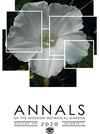被子植物花粉的进化。6.卫矛目、Oxalidales和Malpighiales(Com)分支和Zygophyllales1
IF 1.3
3区 生物学
Q3 PLANT SCIENCES
引用次数: 11
摘要
在当代系统发育框架下分析花粉形态资料,有助于我们更好地理解孢粉学特征的分布、多样性和演化。本文是被子植物花粉形态特征系列的第六篇,重点研究了Celastrales, Oxalidales和malpiighiales (COM)分支和Zygophyllales,共包括47科约20,000种。我们首先利用光镜、扫描电镜和透射电镜对21种植物的花粉粒进行了研究,以说明花粉在COM枝和zygophyll门中的多样性。其次,基于先前发表的花粉数据的重新检查和我们的新观察,我们在最大似然(ML)树上优化了21个花粉特征,这些特征来自45个科169个属,代表所有四个目,使用Fitch简约,ML和层次贝叶斯推理。该类群的花粉形态表现出很大的多样性,特别是在大小、孔数、直肠上元形状和顶盖雕刻等方面。所有方法对COM进化枝的18个字符的似形状态进行了明确的推断,并且在群体内不同层次的谱系中,每种分析都假设了300多个字符状态的变化。在性状的极观轮廓、花粉大小和顶盖雕刻上发生的状态变化最为频繁;分布单元、对称性和顶盖有无等性状的状态变化最少。我们确定了几个单系进化枝的诊断特征状态,并探索了孢粉学证据,以阐明一些未解决的关系。例如,以前分解较差的Malpighiales被发现以单一的花粉特征状态变化(从无环到有环)来区分。进一步证实了花粉孔数(从三孔状态到其他状态)和顶盖雕刻(从穿孔状态到网状状态)等几个重要花粉性状的进化变化模式,并提出了它们可能的适应功能。为了反映当前人们对花粉形态与传粉综合征之间关系的兴趣,我们进行了花粉形态与传粉综合征之间的相关进化测试,结果表明薄的外壁与风病之间存在显著的相关性,出乎意料的是,在直肠上元素的存在与风病之间存在显著的相关性。讨论了先前假设的孔数(增加),顶盖雕刻(从穿孔到网状)和直肠下结构(从小柱状到颗粒状)的进化趋势的证据。在存在或不存在直肠上元素的情况下,相对较高频率的状态变化可能与这一群体中授粉综合征的切换有关。本文章由计算机程序翻译,如有差异,请以英文原文为准。
Evolution of Angiosperm Pollen. 6. The Celastrales, Oxalidales, and Malpighiales (Com) Clade and Zygophyllales1
Abstract
Analyzing pollen morphological data on a contemporary phylogenetic framework can enhance our understanding of the distribution, diversity, and evolution of palynological characters. In this paper, the sixth in a series detailing pollen morphological characters across angiosperms, we focus on the Celastrales, Oxalidales, and Malpighiales (COM) clade and Zygophyllales, together comprising ca. 20,000 species in 47 families within fabids. We first examined pollen grains from 21 species with light, scanning electron, and transmission electron microscopy, to illustrate pollen diversity within the COM clade and Zygophyllales. Second, based on a reexamination of previously published pollen data and our new observations, we optimized 21 pollen characters on a maximum likelihood (ML) tree of 169 genera in 45 families representing all four orders, using Fitch parsimony, ML, and hierarchical Bayesian inference. The pollen morphology of this group displays great diversity, particularly in size, aperture number, supratectal element shape, and tectum sculpture. Plesiomorphic states for 18 characters were inferred unambiguously under all methods for the COM clade, and over 300 character state changes were hypothesized by each analysis on lineages at different levels within the group. Changes of state were found to occur most frequently in the characters outline in polar view, pollen size, and tectum sculpture; changes of state occurred least frequently in the characters dispersal unit, symmetry, and tectum presence/absence. We identified diagnostic character states for several monophyletic clades and explored palynological evidence to shed light on some unresolved relationships. For example, the previously poorly resolved Malpighiales were found to be distinguished by a single pollen character state change (from annulus absent to present). Patterns of evolutionary change in several notable pollen characters, such as the number of pollen apertures (from three to other states) and tectum sculpture (from perforate to reticulate), were further confirmed, and their possible adaptive functions are proposed. Reflecting current interest in the relationship between pollen morphology and pollination syndrome, we conducted tests of correlated evolution between pollen morphology and pollination syndrome, with results demonstrating significant correlations between a thin exine and anemophily and, unexpectedly, between presence of supratectal elements and anemophily. Evidence for previously postulated evolutionary trends in aperture number (increasing), tectum sculpture (from perforate to reticulate), and infratectum structure (from columellate to granulate) is discussed. The relatively high frequency of state changes in presence or absence of supratectal elements may be linked to switches in pollination syndrome within this group.
求助全文
通过发布文献求助,成功后即可免费获取论文全文。
去求助
来源期刊
CiteScore
3.60
自引率
0.00%
发文量
15
期刊介绍:
The Annals of the Missouri Botanical Garden is a quarterly international journal primarily devoted to systematic botany and evolutionary biology. We encourage submissions of original papers dealing with significant advances in the taxonomy, phylogeny, biogeography, paleobiology, and evolution of plants, and in conservation genetics and biology, restoration ecology, and ethnobiology, using morphological and/or molecular characters, field observations, and/or database information. We also welcome reviews and papers on conceptual issues and new methodologies in systematics. Important floristic works will also be considered. Symposium proceedings discussing a broader range of topical biological subjects are also published, typically once a year. All manuscripts are peer-reviewed by qualified and independent reviewers.

 求助内容:
求助内容: 应助结果提醒方式:
应助结果提醒方式:


